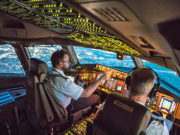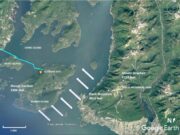The COVID-19 pandemic has eliminated up to 75 percent of aircraft-based weather observations and reduced the accuracy of weather forecasting, especially in busy air traffic sectors in North America, southeastern China and Australia, according to a U.K. study.1
The deterioration of forecast quality could hinder development of early warnings of extreme weather, said a report on the study, part of a collection of COVID-19 reports published online by the American Geophysical Union and intended for publication in the organization’s Geophysical Research Letters journal.
“Weather forecasts play an essential part in daily life, agriculture and industrial activities, and have great economic value,” the report said. “The accuracy of forecasts is largely dependent on the quality of initial conditions used in numerical weather prediction models.”
The number of weather observations has increased steadily in recent decades, in large part because of observations from commercial airliners.
“Assimilation of aircraft observations exerts the largest improvements in global weather forecasts, compared with each individual category of conventional observations (exclude satellite), both for long-term average and for individual events,” the report said.
The number of aircraft observations began dropping in March, however, as the pandemic lockdown took effect, with more than 20 commercial airlines halting all flights and 12 others stopping their international flights, the report said. Cancellation of those flights resulted in the elimination of between 50 and 75 percent of aircraft weather observations from March through May, according to data from the World Meteorological Organization (WMO).
The drastic decline in data, which could intensify along with the pandemic and future flight cancellations, leading to more significant harm to weather forecasting and new economic costs, along with other costs associated with the pandemic, the report said, adding that “further worsening of weather forecasts may be expected and … the error could become larger for longer-term forecasts.”
680,000 Daily Observations
WMO’s Aircraft Meteorological Data Relay (AMDAR) program has relied on more than 3,500 aircraft from about 40 airlines around the world for temperature and wind reports ─ about 680,000 reports daily, the report said. In addition, 100 aircraft, mostly in the United States, provide moisture observations.
Reports of the observations are transmitted every few minutes during cruise flight and every few seconds during takeoff and landing.
During the pandemic, however, the number of reports declined from 102,000 per week in February to 52,000 in the last week of March and 26,000 in the last week of April and in May.
Comparisons
Research compared the accuracy of forecasts for three months of the pandemic (March through May 2020) with their accuracy in March through May of 2017, 2018 and 2019.
Results showed that the accuracy of surface meteorology forecasts for March through May 2020 “decreases markedly” in comparison with the same periods during the three previous years. Forecasts of surface temperature, relative humidity, barometric pressure and wind speed all were affected; forecasts of precipitation were not, the report said.
Degradation of forecasts was more apparent in the Northern Hemisphere than the Southern Hemisphere ─ a result of the larger number of missing weather observations in the North, the report said.
“We notice a much larger degradation in the March−May forecast over some regions than others,” the report said, noting that remote areas, including Greenland, Siberia, Antarctica and the Sahara Desert, have been especially affected.
“This is because assimilation of aircraft observations provides a much larger improvement in forecasts over regions where very limited conventional observations are available,” the report added. “Regions with busy air flights are also affected greatly, such as North America, southeast China and Australia.”
Although a large number of weather observations are reported by airplanes flying above Western Europe, forecasts for the region were affected very little by the loss of those observations because of the “dense network” of meteorological stations on the ground, the report said. “Additional aircraft observations make limited improvement over regions where observation information is almost ‘saturated,’ such as Western Europe.”
An analysis of weather forecasting in the months before the pandemic indicated that accuracy was expected to improve in 2020, compared with previous years, if aircraft weather observations had been conducted as usual.
Instead, without the usual number of aircraft-based observations, the accuracy of surface temperature forecasts could be reduced by as much as 2 degrees C, the report said, adding that a further deterioration is possible if the pandemic and lockdowns continue.
Note
- Chen, Ying. “COVID-19 Pandemic Imperils Weather Forecast.” https://agupubs.onlinelibrary.wiley.com/doi/abs/10.1029/2020GL088613


